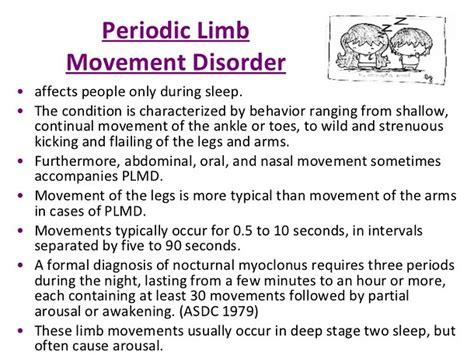Intro
Discover Periodic Limb Movement Disorder symptoms, causes, and treatments. Learn about restless leg syndrome, nocturnal leg cramps, and sleep disruptions, and find relief from involuntary limb movements and nighttime twitching.
Periodic limb movement disorder (PLMD) is a condition that affects millions of people worldwide, causing significant disruptions to their sleep patterns and overall quality of life. Despite its prevalence, PLMD remains a poorly understood condition, and many individuals struggle to recognize its symptoms and seek proper treatment. In this article, we will delve into the world of PLMD, exploring its symptoms, causes, and treatment options, to help raise awareness and promote a better understanding of this debilitating condition.
The importance of addressing PLMD cannot be overstated, as it can have far-reaching consequences on an individual's physical and mental health. People with PLMD often experience excessive daytime sleepiness, fatigue, and decreased productivity, which can impact their work, relationships, and daily activities. Moreover, PLMD has been linked to various other health conditions, such as diabetes, high blood pressure, and cardiovascular disease, making it essential to recognize and manage its symptoms effectively. By shedding light on the symptoms and treatment options for PLMD, we hope to empower individuals to take control of their health and improve their overall well-being.
PLMD is characterized by recurring episodes of involuntary limb movements during sleep, typically occurring in the legs but sometimes affecting the arms as well. These movements can range from mild to severe and can occur repeatedly throughout the night, disrupting the normal sleep cycle and leading to fragmented sleep. The symptoms of PLMD can be subtle, making it challenging for individuals to recognize the condition, but being aware of the warning signs is crucial for seeking proper diagnosis and treatment. In the following sections, we will explore the symptoms, causes, and treatment options for PLMD in greater detail.
Introduction to Periodic Limb Movement Disorder

Types of Periodic Limb Movement Disorder
PLMD can be classified into two main types: primary and secondary. Primary PLMD occurs on its own, without any underlying medical condition or medication, while secondary PLMD is caused by an underlying condition or medication. Primary PLMD is often associated with other sleep disorders, such as restless legs syndrome (RLS), while secondary PLMD can be caused by a range of factors, including iron deficiency, kidney disease, or certain medications.Symptoms of Periodic Limb Movement Disorder

Causes of Periodic Limb Movement Disorder
The exact causes of PLMD are still not fully understood, but research suggests that it may be related to: * Abnormalities in the brain's dopamine system * Iron deficiency or other nutritional deficiencies * Underlying medical conditions, such as kidney disease, diabetes, or peripheral neuropathy * Certain medications, such as antidepressants or antihistamines * Genetics, with some families showing a higher incidence of PLMDTreatment Options for Periodic Limb Movement Disorder

Medications may be prescribed to help manage symptoms, such as:
- Dopaminergic agents, such as ropinirole or pramipexole, to regulate dopamine levels
- Opioids, such as tramadol or oxycodone, to reduce pain and discomfort
- Benzodiazepines, such as clonazepam or alprazolam, to promote relaxation and reduce anxiety
- Iron supplements, to address iron deficiency or other nutritional deficiencies
Alternative therapies, such as acupuncture or massage, may also be beneficial in reducing stress and promoting relaxation.
Living with Periodic Limb Movement Disorder
Living with PLMD can be challenging, but there are several strategies that can help individuals manage their symptoms and improve their quality of life. These include: * Keeping a sleep diary to track sleep patterns and identify triggers * Establishing a relaxing bedtime routine, such as reading or listening to music * Avoiding screens and electronic devices before bedtime * Engaging in regular exercise and physical activity to reduce stress and promote relaxation * Seeking support from family, friends, or a support group to cope with the emotional and psychological impact of PLMDConclusion and Future Directions

Final Thoughts
PLMD is a condition that affects millions of people worldwide, causing significant disruptions to their sleep patterns and overall quality of life. By recognizing the symptoms and seeking proper treatment, individuals can manage their condition and improve their overall well-being. We hope that this article has provided valuable insights and information about PLMD, and we encourage readers to share their experiences and thoughts in the comments below.What is the main symptom of Periodic Limb Movement Disorder?
+The main symptom of Periodic Limb Movement Disorder is recurring episodes of involuntary limb movements during sleep, typically occurring in the legs but sometimes affecting the arms as well.
How is Periodic Limb Movement Disorder diagnosed?
+Diagnosis of Periodic Limb Movement Disorder typically involves a physical examination, medical history, and sleep study to monitor sleep patterns and limb movements.
What are the treatment options for Periodic Limb Movement Disorder?
+Treatment options for Periodic Limb Movement Disorder include lifestyle modifications, medications, and alternative therapies, such as acupuncture or massage, to manage symptoms and improve quality of life.
